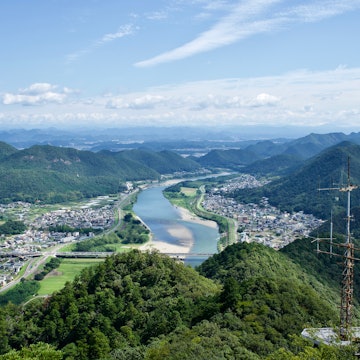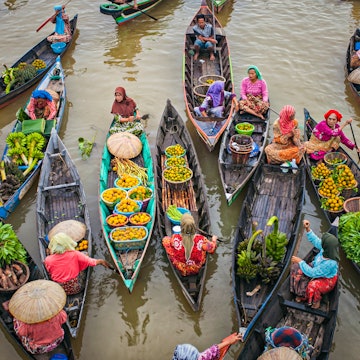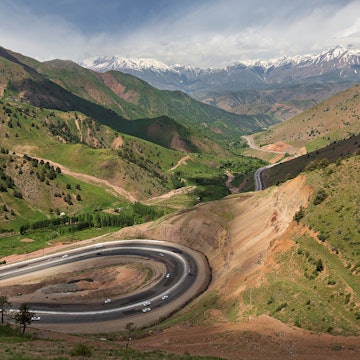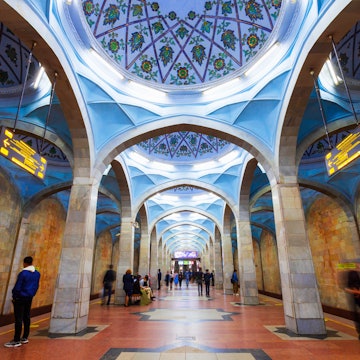
Joining the bikers of Gilgit-Baltistan: exploring Northern Pakistan by motorcycle

Dec 17, 2019 • 6 min read

Each time I look down to place a shoe on my right foot, I’m confronted with the memory of jagged, ash-gray mountains. The cause? A circular burn on the front of my shin, made by the hot bite of a motorbike's exhaust pipe (a Suzuki GS150, to be precise) that I lifted up too carelessly from the road in Pakistan’s northern regions.
Glancing at that scar is like torture: it shoots me back to Gilgit-Baltistan’s divine barrage of snow-capped giants. Indelible, the memory soars from the back of my neck, pushing hard until the mountains completely fill my mind with their diamond-like shapes. After you've seen them once, they’ll never let you go.

The changing landscape of Pakistan
Yes, you’ve read that right: Pakistan. In summer 2019 – twisted over a rental motorbike – I set out on two wheels to explore the Karakoram Highway, travelling from Gilgit to 4693m-high Khunjerab Pass. It’s the highest land border in the world, where Pakistan meets the fringes of China’s Xinjiang province.
Pakistan’s Northern Areas – wedged between the Himalayas, the Hindu Kush and the Karakoram mountain ranges of Central Asia – have been astounding travellers since the 1970s, when drifters on the overland Hippie Trail between London and India discovered Gilgit-Baltistan.
But after the 11 September attacks ignited terrorist activity in Pakistan’s main cities, sectarian violence erupted near Gilgit in 2012, and in 2013 ten foreign mountaineers were shot dead on the Nanga Parbat peak. Few considered going back until now.

A ticket to ride
As I speed down the perfectly-paved Karakoram Highway, the sun shines, ice-capped mountains shimmer, locals wave at me to stop for tea and a friendly chat, and the idea of this high-altitude desert as anything other than tranquil seems ridiculous.
I let the cylinders of the Suzuki roar as I sail past turquoise Attabad Lake, a shrinking beauty born of the tragic floods that wrecked the region in 2010, before skirting the Passu Cones, rising like bone-dry fangs from the half-buried jaw of a colossal dragon skeleton.
This is actually my second time motorbiking in Pakistan: in 2018, getting a visa required obtaining an official invitation letter, embassy interviews, and coping with a string of endless police checkpoints hungry for copies of my passport’s data and visa pages.
This year, however, the only thing watching over me as I drive from Gilgit to Karimabad, Hunza’s main tourist boomtown, is the almost vertical peak of 7788m-high Rakaposhi.

With the sun still high in the sky, I ride from the Unesco-inscribed Baltit Fort of Karimabad, a medieval mud and brick citadel set at the bottom of vertical mountains, to the top of the Eagle’s Nest viewpoint.
Navigating bend after bend, I push the Suzuki’s engine up a narrow mountain road; it's dotted with stone houses, roaming cattle and local folks working their fruit orchards, the smell of fresh apricots drying in the sun perfuming the cold mountain air.
Upon reaching the viewpoint I cut the engine and clamber up onto a boulder to take in the views. I see the dormant giant Rakaposhi snuggling with its brothers and sisters to form an amphitheatre of rock, clouds and sky all around, dwarfing me as if I were an anchovy in a chasmic rock pool. From this vantage point, danger truly feels like the last of my concerns.
Then, suddenly, an involuntary yelp fills the air, followed by a searing pain on the front of my right shin; and within an instant the memory of the mountains is scorched onto my leg forever.

Conscientious bikers
The rebirth of tourism in Gilgit-Baltistan was fuelled by the resolute efforts of a grassroots group of bikers.
“I was sad that such a place of extreme natural beauty and kind local people was so obviously and completely misunderstood by almost all the planet,” says Liz Norman, the Australian behind Karakoram Bikers, the motorbike tour company she founded with her Pakistani husband, Syed Hamza Mobeen.
In the last couple of years, the pair have helped hundreds of travellers come to Pakistan by offering ‘letters of invitation’, guided motorbike tours, and self-drive bike rentals for the most independent riders – such as myself. Their main aim is to offer travellers the experience of a lifetime, so that they may go back to their own countries and spread the good news about travelling to Pakistan by word of mouth and social media.
“The result is that more travellers are arriving year after year, especially now that the government of Pakistan started a new online visa system,” says Syed Hamza Mobeen, who fell in love with Gilgit-Baltistan after completing his first bike trip, though ill-equipped, between university terms in Lahore a few years ago.
But higher numbers of tourists to the region – which is now also receiving many unexpected domestic trippers – must be properly managed to avoid damaging these very fragile glacial ecosystems.
“We still need to educate tour operators, hotel managers and drivers,” concludes Syed Hamza Mobeen. “This paradise will only survive if proper rubbish management, precise regulations on national park entry permits, and proper toilet facilities in tourist areas are set in place.”

How to do it yourself
Gilgit-based Karakoram Bikers rents bikes from PKR2000 per day and organises Pure Pakistan, a two- to three-week guided motorbike tour of the region. Their homestay, Five Giants in nearby Danyor, is perfect to meet other travellers and relax away from gridlocked Gilgit.
In Hunza, Rehman Backpackers Hostel in Ghulkin village, near Passu Cones, has dorms (PKR1000), en-suite doubles (from PKR2500) and an adorable family atmosphere. For a splurge, the Hunza Serena Inn offers the best rooms in the region.
Camping is possible, but remains a grey area: ask locals before pitching your tent.
How to get there
Islamabad, the nearest international airport, has daily flights to Gilgit. Cancellation due to bad weather is common, in which case it’s a long 16 hours on a bus. Natco and Faisal Movers buses are recommended. The more scenic route via Naran and the Babusar Pass is only open in the summer.

Best time to go
Hunza is hot and dry from June to September. The shoulder months of May and October, when autumn colours fire up the valley and temperatures are still mild, are also ideal for riding. You may also consider visiting during the fasting month of Ramadan when Hunza is free from local tourists. You’ll still be able to find food during the day – the local Ismaili Muslims are quite moderate.
Visa requirements
Travellers can apply for a Pakistan visa in their own countries, but there's a new simplified online visa system for citizens of 175 countries, including the UK and USA. Online tourist visas cost US$35 for most nationalities and take between a couple of days and a week to be issued by email.
A letter of invitation by a tour operator may be required, but in most cases it is sufficient to provide hotel bookings for the first days of your stay. You can overstay a Pakistani visa up to 14 days free of charge, but once in Pakistan, eVisas can be easily extended online for US$20 for up to six months.
Safety and security
Despite recent improvements, foreign governments still advise against travel to several areas of Pakistan. Seek up-to-date advice on the situation in the areas you plan to visit before travelling.













